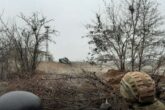February 18, 2022
The Full Potential of a Military Metaverse
This article was originally published by War on the Rocks.
From butterfly gardens to photorealistic avatars and mixed-reality fitness, Facebook’s rebranding announcement was followed by an hour-long exploration of the tools and experiences that may evolve in the company’s vision for the metaverse. Unsurprisingly, this drove a significant uptick in interest, with search results skyrocketing for the term on Google. Meta-inspired metaverse hype seems to be at an all-time high.
In the past year, and particularly since Meta’s announcement, a plethora of other players — to include our own company — have announced their intention to build the tools that will facilitate the emergence of a metaverse — from gaming companies to enterprise software giants and, of course, social media behemoths. The defense industry has not been immune to this sudden bow wave of enthusiasm, with the metaverse becoming one of the newest buzzwords to hit the Beltway.
Defense companies and outlets offer a steady drip of articles and the metaverse is already slated to be one of the core themes of numerous defense conferences.
Like any newfangled term that captures the febrile imagination of the national security community, identifying what the metaverse means for defense isn’t always an easy task. For many, a defense metaverse appears to be merely the latest faddish concept in a dense constellation of defense jargon — a superficially explored term that draws excitement and ridicule in equal measure. And when the metaverse is discussed in a more substantive way in defense circles, it is often solely — and somewhat reductively — equated with training. In reality, however, should a metaverse or the metaverse actually materialize, it will elicit broader implications for defense — something that therefore warrants far deeper analysis. Indeed, a defense metaverse could emerge simultaneously as a key tool to enhance battlefield effectiveness and as a forum for intra-military communication and exchanges.
Read the full article from War on the Rocks.
More from CNAS
-
Defense / Transatlantic Security
When Defense Becomes Destruction: Austria-Hungary’s Mistake and Ukraine’s RiskThis article was originally posted on War on the Rocks. The southeastern Polish city of Przemyśl, with its elegant 19th century Habsburg-era train station, remains one of the ...
By Franz-Stefan Gady
-
Defense / Transatlantic Security
Ukraine’s Catch-22 MomentThis article was originally published in the Financial Times. In Joseph Heller’s wartime classic, Catch-22, the protagonist Yossarian seeks out the US army surgeon Doc Daneeka...
By Franz-Stefan Gady
-
CNAS Insights | Budgetary Own Goals Undermine “Speed and Volume”
On November 7, Secretary of Defense Pete Hegseth laid out a plan to overhaul the Department of Defense’s (DOD’s) acquisition system. Placing an emphasis on delivering new capa...
By Philip Sheers, Carlton Haelig & Stacie Pettyjohn
-
Drones: Who Is Making the New Weapons of War?
From Ukraine and Russia to Gaza and Sudan, drones have become a key weapon of war. Which companies are making them, and profiting from this rapidly expanding but controversial...
By Stacie Pettyjohn




